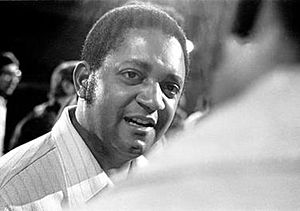Oliver Nelson facts for kids
Quick facts for kids
Oliver Nelson
|
|
|---|---|
 |
|
| Background information | |
| Birth name | Oliver Edward Nelson |
| Born | June 4, 1932 St. Louis, Missouri, United States |
| Died | October 28, 1975 (aged 43) Los Angeles, California |
| Genres | Bebop, hard bop, post-bop, jazz fusion |
| Occupation(s) | Musician, composer, arranger |
| Instruments | Soprano saxophone, alto saxophone, tenor saxophone, and clarinet |
| Labels | Verve Impulse! Prestige Argo Flying Dutchman |
Oliver Edward Nelson (born June 4, 1932 – died October 28, 1975) was an American jazz musician. He played the saxophone and clarinet. He was also a talented arranger, composer, and bandleader. His 1961 album The Blues and the Abstract Truth is considered one of the most important jazz recordings of its time. A very famous song from this album is "Stolen Moments". Other important albums from the early 1960s include More Blues and the Abstract Truth and Sound Pieces.
Contents
About Oliver Nelson
Early Life and Musical Start
Oliver Nelson was born in St. Louis, Missouri, United States. He grew up in a family full of musicians. His brother played the saxophone, and his sister sang and played piano. Oliver started learning piano when he was six years old. He began playing the saxophone at age eleven.
In 1947, he started playing in local bands around St. Louis. From 1950 to 1951, he played alto saxophone with the Louis Jordan band. He also helped arrange music for Jordan's band.
Military Service and Education
In 1952, Nelson joined the United States Marine Corps. He played woodwind instruments in the 3rd Marine Division band in Japan and Korea. While in Japan, he went to a concert by the Tokyo Philharmonic Orchestra. He heard music by composers like Maurice Ravel and Paul Hindemith. This experience made him want to become a composer. He realized that music could sound very different from the classical music he knew.
After his military service, Nelson returned to Missouri. He studied music composition and theory at Washington University in St. Louis and Lincoln University. He earned a master's degree in 1958. He also studied with famous composers like Elliott Carter.
Moving to New York and Early Career
After finishing his studies, Nelson moved to New York City. He played with musicians like Erskine Hawkins. He also worked as the main arranger for the Apollo Theater in Harlem. In 1959, he recorded his first albums as a band leader for Prestige Records.
From 1960 to 1961, he briefly played with jazz legends Count Basie and Duke Ellington. He then joined the Quincy Jones big band. He played tenor saxophone with them in the U.S. and during a tour in Europe.
Becoming Famous
Oliver Nelson had already released six albums as a leader. But his big success came with The Blues and the Abstract Truth. This album was recorded for Impulse!. It featured other great jazz musicians like Eric Dolphy and Freddie Hubbard. This album made him very well-known as a composer and arranger. After this, he recorded several other popular big-band albums. These included Afro-American Sketches and Full Nelson.
Nelson also worked as an arranger for many other famous musicians. He arranged music for Thelonious Monk, Cannonball Adderley, Sonny Rollins, and Wes Montgomery. He arranged the music for the film Alfie (1966). He also led all-star big bands in live shows from 1966 to 1975. During this time, he often performed as a soloist, focusing on the soprano saxophone.
Music for TV and Movies
In 1967, Nelson moved to Los Angeles. This allowed him to work more in the television and movie industries. He became very popular for composing background music for TV shows and films. His TV projects included Ironside, Night Gallery, Columbo, and The Six Million Dollar Man.
He also scored films like Death of a Gunfighter (1969) and Zig Zag (1970). He even arranged music for the movie Last Tango in Paris (1972). During this busy period, he arranged and produced albums for pop stars. These included Nancy Wilson, James Brown, The Temptations, and Diana Ross.
Teaching and Later Years
Besides his big-band performances, Nelson also led a smaller group. In 1969, this group toured West Africa. Nelson also cared deeply about jazz education. He returned to his old university, Washington University in St. Louis, in 1969. There, he led a five-week music workshop. Famous musicians like Phil Woods and Thad Jones were guest performers. Some of his students later formed the World Saxophone Quartet. Nelson also wrote a book of jazz exercises called Patterns for Improvisation in 1966. It is still highly respected today.
Oliver Nelson passed away on October 28, 1975, when he was 43 years old.
Discography
See also
 In Spanish: Oliver Nelson para niños
In Spanish: Oliver Nelson para niños

